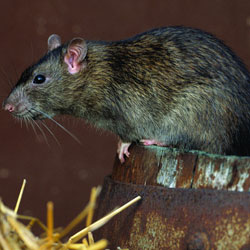The Norway rat is a stocky burrowing rodent. Also called the brown rat, house rat, barn rat, sewer rat, gray rat, or wharf rat, it is a slightly larger animal than the roof rat. Adult Norway rats weigh an average of 1 pound. Their fur is coarse and usually brownish or reddish gray above and whitish gray on the belly. Norway rats are primarily nocturnal. They usually become active about dusk, when they begin to seek food and water. Some individuals may be active during daylight hours when rat populations are high.
Rats have poor eyesight, relying more on their hearing and their excellent sense of smell, taste, and touch. They are considered color-blind. Therefore, for safety reasons, baits can be dyed distinctive colors without causing avoidance by rats, as long as the dye does not have an objectionable taste or odor.
Rats use their keen sense of smell to locate food items and to recognize other rats. Their sense of taste is excellent, and they can detect some contaminants in their food at levels as low as 0.5 parts per million.
Norway rats usually construct nests in below-ground burrows or at ground level. Nests may be lined with shredded paper, cloth, or other fibrous material. Litters of 6 to 12 young are born 21 to 23 days after conception. Newborn rats are hairless and their eyes are closed, but they grow rapidly. They can eat solid food at 2 1/2 to 3 weeks. They become completely independent at about 3 to 4 weeks and reach reproductive maturity at 3 months of age.
Females may come into heat every 4 or 5 days, and they may mate within a day or two after a litter is born. Breeding often peaks in spring and fall, with reproductive activity declining during the heat of summer and often stopping completely in winter, depending on habitat. These seasonal trends are most pronounced in more severe climates. The average female rat has 4 to 6 litters per year and may successfully wean 20 or more offspring annually.
Prevention Tips
Regular removal of debris and control of weeds from around structures will reduce the amount of shelter available to rats.
Keep the perimeter of buildings and other structures clean of weeds and debris (including stacked lumber, firewood, and other stored materials) to discourage rodent activity and to allow easier detection of rodent sign.
Store bulk foods in rodent-proof containers.
Repair all holes and cracks around exterior larger than the diameter of a quarter, using steel mesh.

